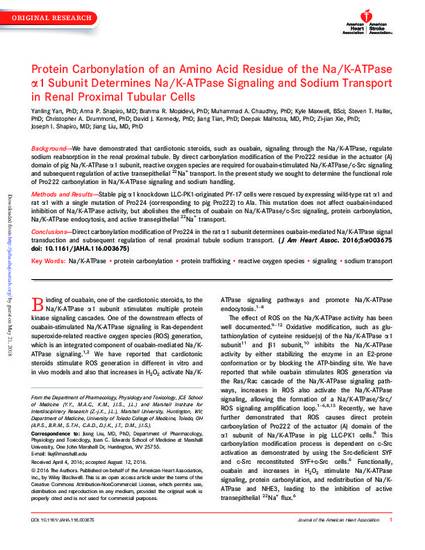
Background We have demonstrated that cardiotonic steroids, such as ouabain, signaling through the Na/K‐ATPase, regulate sodium reabsorption in the renal proximal tubule. By direct carbonylation modification of the Pro222 residue in the actuator (A) domain of pig Na/K‐ATPase α1 subunit, reactive oxygen species are required for ouabain‐stimulated Na/K‐ATPase/c‐Src signaling and subsequent regulation of active transepithelial 22Na+ transport. In the present study we sought to determine the functional role of Pro222 carbonylation in Na/K‐ATPase signaling and sodium handling.
Methods and Results Stable pig α1 knockdown LLC‐PK1‐originated PY‐17 cells were rescued by expressing wild‐type rat α1 and rat α1 with a single mutation of Pro224 (corresponding to pig Pro222) to Ala. This mutation does not affect ouabain‐induced inhibition of Na/K‐ATPase activity, but abolishes the effects of ouabain on Na/K‐ATPase/c‐Src signaling, protein carbonylation, Na/K‐ATPase endocytosis, and active transepithelial 22Na+ transport.
Conclusions Direct carbonylation modification of Pro224 in the rat α1 subunit determines ouabain‐mediated Na/K‐ATPase signal transduction and subsequent regulation of renal proximal tubule sodium transport.

The copy of record is available at https://doi.org/10.1161/JAHA.116.003675. Copyright © 2016 The Authors. Published on behalf of the American Heart Association, Inc., by Wiley Blackwell. This is an open access article under the terms of the Creative Commons Attribution-NonCommercial License, which permits use, distribution and reproduction in any medium, provided the original work is properly cited and is not used for commercial purposes.